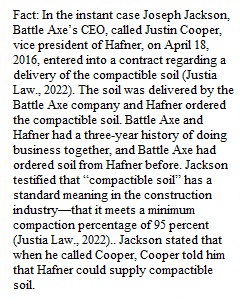


Q 3-3: Case Study • Points 80 • Submitting a file upload Purpose The purpose of this assignment is to assess your ability to write a legal research memorandum. Action Items 1. Write a 2- to 3-page research memorandum based on the court case as assigned by your professor (posted under the Announcements section of the course). 2. Structure your memo as follows: a. Audience and Structure: Choose who you are going to send the memo to, such as the CEO of a company, business owner, etc. Complete the rest of the memo headings. Make sure the top part of your memo is complete, including TO, CC (carbon copy), FROM, DATE, and RE (reason). b. Facts: Succinctly state the facts relevant to the resolution of the case you are analyzing. Doing so involves reviewing the facts to include only those relevant to answering the question(s) at issue in your memorandum. c. Question(s) Presented: State the question or questions your memorandum seeks to answer. If possible, present it in a single sentence or two (e.g., “Will Mr. Smith have to include the value of the property in his income?”). Most (if not all) of the memoranda you will be assigned will present a single, overarching question. Granted, there may be multiple issues that you have to analyze to answer this question, but all of them go toward answering the larger question, such as whether the taxpayer has to include the value of some property in his or her income. d. Short Answer: State the answer to the “Question(s) Presented” as clearly and succinctly as possible—again, preferably in a single sentence or a few sentences. (For example, your Short Answer to the Question Presented above might be, “Mr. Smith will have to include the value of the property in his income.”) e. Analysis: This is the substantive portion of your memorandum and is worth the majority of the points on the assignment. It is where you present all of the analysis that is required to support your Short Answer. In performing your analysis, you should use the general “IRAC” approach Download general “IRAC” approachyou have learned and utilized to date, although you will not have specific sections within the Analysis listed as “Issue, ” “Rule, ” “Analysis, ” and “Conclusion. ” Once you have identified the issue or issues that you have to resolve to answer the Short Answer, you should address the authority for your position. Your analysis for each of these issues should review these authorities and then apply them to the facts of the case to draw conclusions. f. Recommendations: Finally, it is very important that you analyze the case from a business perspective and provide recommendations on how a business could have avoided or mitigated the legal issue involved in the case. What recommendations will you make to management to prevent this issue from occurring in the future? 3. By the due date, submit your assignment. Rubric Case Study Case Study Criteria Ratings Pts This criterion is linked to a Learning OutcomeCritical Thinking 45 to >36.0 pts The student answers all of the required questions in the assignment. Main ideas are very clear. Content is all relevant to the material learned in the class/textbook. Content is correct and of high quality. 36 to >31.0 pts The student answers most of the required questions in the assignment. Main ideas are generally clear. Content is generally relevant to the material learned in the class/textbook. Content is generally correct and of high quality. 31 to >0 pts The student answers none or only some of the required questions in the assignment. Main ideas are confusing or somewhat confusing. Content is irrelevant or somewhat irrelevant to the material learned in the class/textbook. Content is incorrect or somewhat incorrect and of low quality. 45 pts This criterion is linked to a Learning OutcomeSupport 25 to >20.0 pts The student provides abundant evidence of analysis; the information is understood and integrated well. Synthesis of information and materials provides abundant evidence of critical thought. 20 to >18.0 pts The student provides evidence of analysis; the information is understood and integrated overall. Synthesis of information and materials provides evidence of critical thought. 18 to >0 pts The student provides no or only some evidence of analysis; the information is not understood and integrated well. Synthesis of information and materials provides no or only some evidence of critical thought. 25 pts This criterion is linked to a Learning OutcomeMechanics 10 to >8.0 pts The assignment contains no notable spelling, grammatical, and/or other errors. 8 to >7.0 pts The assignment has few spelling, grammatical, and/or other errors. 7 to >0 pts The assignment has many spelling, grammatical, and/or other errors. 10 pts Total Points: 80
View Related Questions